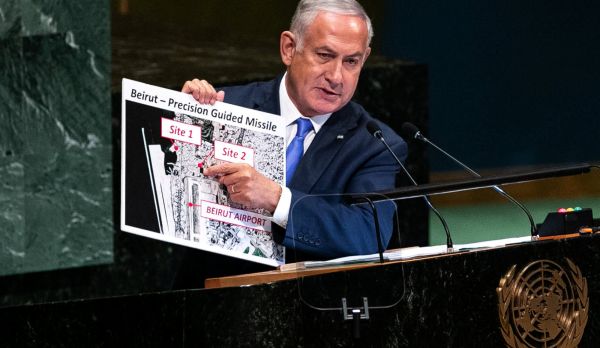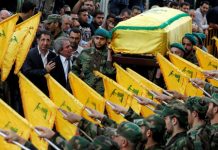Analysis/Where Netanyahu Sees an Iranian Threat, His New Defense Chief Sees an Opportunity
عاموس هاريل/هآرتس: نيتنياهو يرى أن هنالك تهديداً إيرانياً فيما وزير دفاعه يرى في الأمر فرصة
Amos Harel/Haaretz/November 29/2019
However, setbacks in Iran’s expansionist military project in Syria won’t change Tehran’s long-term agenda
On Sunday, Prime Minister Benjamin Netanyahu and Defense Minister Naftali Bennett took a tour of the northern part of the country. Accompanied by Israel Defense Forces Deputy Chief of Staff Maj. Gen. Eyal Zamir and Northern Command chief Maj. Gen. Amir Baram, they visited troops from the Galilee Division, responsible for security along the Lebanon border, and the Bahsan Division, in charge of the border with Syria.
Security issues are apparently serving the prime minister’s own purposes, more than they are giving him sleepless nights. Constantly raising the public’s awareness of military dangers heightens Netanyahu’s image as the country’s great defender, and ostensibly justifies his remaining in power, despite the indictments. The visit took place a few days after four Fajr-5 rockets were fired at Mount Hermon from Syria by Iranian-controlled Shi’ite militias from the southern outskirts of Damascus. The rockets were intercepted by the Iron Dome system, and Israel responded with an extensive attack on Iranian and Syrian military sites in southern Syria. During their tour, Netanyahu and Bennett reiterated the usual threats against Iran, Syria, Hezbollah and Israel’s other enemies. The impression created was that Israel is determined to use all means at its disposal to combat the Iranian danger looming on its borders.
The trip north was, of course, entirely political. Just a few days earlier, Attorney General Avichai Mendelblit had announced his decision to file corruption charges against Netanyahu in three cases; two days later, thousands of supporters of the prime minister gathered at a solidarity rally for him in Tel Aviv.
These days, Netanyahu is simultaneously waging a battle of vilification against the attorney general and state prosecutors, deploying to defend himself ahead of the possible lifting of his immunity by the Knesset, and also stonewalling, in the hope of thwarting last-minute efforts by his rivals (in Kahol Lavan as well as in Likud) to form a new government without another election.
The tour of army installations on Wednesday by Kahol Lavan leader MK Benny Gantz and others from his party paled in comparison to Netanyahu’s. Moreover, Gantz, unlike Netanyahu and Bennett, isn’t entitled to have his picture taken with IDF officers at his side.
A sensitive ear would have noted a difference in tone between the remarks made by the prime minister and those of the defense minister, when they were up north. The former pursued his alarmist line: The Iranians are lurking at the Syrian border, and they are building missile bases in Iraq and in Yemen in order to threaten Israel from those regions. Bennett sounded different, almost gung-ho, and addressed the Iranians directly: “There’s nothing for you in Syria, there’s no reason for you to try and consolidate yourselves there. Whatever you try to do, you will encounter a strong and determined IDF that will strike at you.”
Where Netanyahu talks about a threat, his defense minister perceives an opportunity. The Iranians, he believes, made a mistake in deciding to move their campaign close to the border with Israel. Establishing themselves militarily in southern Syria requires a long and vulnerable logistical chain, stretching all the way from Tehran to Damascus. Deployment of militias on the Golan Heights front allows Israel intelligence and air superiority, close to home. Iran will have a very hard time closing that gap, no matter what quantities of materiel and troops it may try to deploy along the border.
Moreover, the riots in Iraq, Lebanon and, recently in Iran as well, require the authorities to focus their attention and energies to dealing with domestic troubles. Hezbollah has no desire whatsoever to be dragged into a war with Israel at this time, as Iran’s proxy. That situation, according to Bennett, leaves General Qasem Soleimani, commander of the Quds Force in the Revolutionary Guards, with a limited power of response – mostly from Syria and western Iraq. Those are dangers that Israel can handle, if necessary by delivering more potent blows.
Managing the risks
Where Bennett portrays Iran as an octopus, extending its tentacles across the Middle East, Israeli intelligence thinks of it as a hedgehog. The local arena is of most concern to Tehran’s leadership, which is in a permanent state of “battle readiness” and sees conspirators in every corner. On Wednesday, following what appears to have been the successful brutal suppression of demonstrations in Iran against the spike in fuel prices – estimates in the West are that more than 300 protesters were killed and about 4,000 wounded – Supreme Leader Ali Khamenei declared that the Iranian people had “quelled a broad and dangerous conspiracy that was led by foreign agents.”
Moreover, Iran remains under huge economic pressure due to the American sanctions. Its military actions, notably the attacks on petroleum sites in the Persian Gulf, are intended primarily to create counter-pressure against the West and to force the United States to relent.
And the domestic crisis has not gone away. On the 40th anniversary of the Islamic Revolution, Iran’s revolutionary fervor has faded, and what remains is mainly the suppression. Some experts say that the current situation recalls the period leading up to the dissolution of the Soviet Union, even if the Tehran’s regime’s expiry date is far from clear.
Was Iran’s military expansion as far as Syria really a mistake? Tehran, according to Jerusalem’s reading, has a different conception of time. Individual failures, in firing rockets or being bombed by Israel, do not necessarily alter the long-term view. The major concern in Israel is Soleimani’s risk-management policy; in the meantime, he’s getting a free hand from the leader. Is he liable to gamble irresponsibly and expand the friction into an all-out military confrontation with Israel? That’s a danger that lurks more vividly in Lebanon than in Syria. Israel has stated that the establishment of facilities in Lebanon for manufacture of precision weapons will not be tolerated under any circumstances. The Iranians, for their part, have not desisted from their efforts to promote such a project, together with Hezbollah.
Broken promises
In the summer of 2018, the regime of Bashar Assad completed the recapture of southern Syria. The Russian forces in the country succeeded in dismantling most of the strongholds of resistance to the Syrian ruler. When the Russians threatened carpet bombing, a method of warfare they had previously demonstrated in Aleppo, the majority of leaders in the insurgent villages signed surrender agreements. In return for not intervening in events in the Syrian Golan, Israel was promised that the front would remain quiet.
A Russian-American-Jordanian agreement, and verbal assurances as well from Moscow, stipulated that Iran and its satellites would not be allowed to draw closer than 70 or 80 kilometers (43-49 miles) from the border (there are different accounts about the distance). Netanyahu supporters presented the understandings as a tremendous strategic achievement, one that would not have come to pass were it not for the prime minister’s close friendship with Russian President Vladimir Putin.
None of the Russians’ promises were kept: Iran and its proxies are present on almost every square meter of ground between Damascus and the Israeli border. In the Israeli punitive attacks on November 20, a large number of targets – most of them Iranian, a few Syrian – were hit in the area between Damascus and the border. On bases near Damascus, within the strip that was supposed to be empty of Iranians, the Revolutionary Guards and the Shi’ite militias have deployed a range of weapons systems, some of which, such as the Fajr rockets, can hit Israel. (More advanced systems have for the most part been limited to the area north and east of Damascus, for fear of Israeli strikes.) And deployed all along the Golan Heights front, and in the rear as well, are observation posts, Syrian units with Iranian advisers, weapons experts from Hezbollah, and local terrorist and guerrilla networks that Hezbollah is setting up.
The potential of the Syrian border becoming active, as a secondary front in the event of war erupting between Israel and Hezbollah in Lebanon, already exists. And since February 2018 – the first instance in which Iran tried to attack Israel from Syria (with a drone. carrying explosives) – there have been six incidents in which rockets, drones and multirotors have been launched by the Iranians or by militias operating at their directive.
What is the chance that Israel will be able to persuade them to recalculate their course of action, as Bennett believes? The final decisions will probably be made in Tehran. The Syrian regime is not happy about the idea of absorbing collateral damage from Israel, as in the recent attack, because of the Iranians. Russia, too, has no interest in seeing Iranian military consolidation in Syria thrive. However, at present, neither Damascus nor Moscow appears overly willing to confront Tehran on this issue.





















